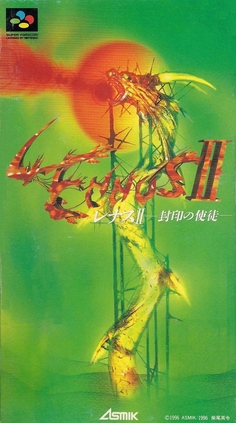Software:Lennus II
| Lennus II: Fūin no Shito | |
|---|---|
 | |
| Developer(s) | Copya System |
| Publisher(s) | Asmik Corporation |
| Director(s) | Hidenori Shibao |
| Composer(s) | Kōhei Tanaka |
| Platform(s) | Super Famicom |
| Release | |
| Genre(s) | Role-playing video game |
| Mode(s) | Single-player |
Lennus II: Fūin no Shito (レナスII 封印の使徒, "Lennus II: The Apostles of the Seals") is a 1996 role-playing video game for the Super Famicom. It was developed by Copya System, and published by Asmik Corporation.
Story
The game takes place on the moon named "Eltz" that orbits the planet "Raiga".[1] The first game took place on Lennus, another moon of Raiga.[1] The plot centers around a hero, Falus.[2]
Gameplay
Gameplay is fairly similar to the original Lennus / Paladin's Quest:
- The player can swap out mercenary equipment.
- There have been some revisions to the magic system.
- There are eight spirits: Fire, Light, Wind, Gold, Earth, Sky, Water and Void, with one spell for each spirit and each pair of spirits, for 36 spells.
- Falus starts the game with three of the eight spirits, and can gain the powers of the other five through sidequests. He can only cast spells from the spirits he currently has equipped, and only has a limited number of slots (starting with only a single slot, with three more slots unlockable through sidequests for a maximum of four, allowing up to 10 of the 36 spells to be available at a time), and can only swap spirits outside of combat.
- Much like in Paladin's Quest, each mercenary has a fixed repertoire of spirits, which are automatically equipped and cannot be swapped out.
- Instead of building up spirit skill ratings by repeatedly casting associated spells, in Lennus II, spirits are powered up by defeating monsters, who yield a sort of spirit-specific experience points in addition to regular experience points.
Development
The game was developed by Copya system,[3] and published by Asmik Corporation.[4] It is a sequel to Lennus: Memory of the Ancient Machine.[5] Enix brought the original Lennus to North America as Paladin's Quest.[5][3]
The game was directed and written by Hidenori Shibao, who also directed the original.[5][6] The music for the game was made by Kohei Tanaka.[7] Shibao was writing strategy guides and making 20 million yen per year, but working on Lennus II he was only making 2 million yen a year.[1] The game took four years to finish, instead of the planned two years.[1] Shibao says "It was like the entire project was cursed!"[1]
Developer Copya System changed its name to "Shangri-La" in 1996.[3]
Release
Lennus II was released on July 28, 1996 for the Super Famicom.[4] A Nintendo Power version was released on December 1, 1997.[4] According to Shibao the game didn't sell well and he described it as "a huge bomb".[1] For that reasons, plans for Lennus III were shelved, and the game was never made.[1] The plot for the third game would have focused on the planet Raiga itself, and the construction of the two moons.[1]
Enix had closed its American headquarters by this time, and focus shifted to the Nintendo 64.[2] The game has never been released outside of Japan.[8][3] However, a fan translation of the game into English was created for it in 2008.[9][2]
Two tracks from the game were recorded by the Tokyo Philharmonic Orchestra for release on the Orchestral Game Concert compilations.[10][11]
References
- ↑ 1.0 1.1 1.2 1.3 1.4 1.5 1.6 1.7 "Feature: A Memorial For Hidenori Shibao" (in en-GB). Nintendo Life. 2018-04-09. http://www.nintendolife.com/news/2018/04/feature_a_memorial_for_hidenori_shibao.
- ↑ 2.0 2.1 2.2 "Lennus II – Hardcore Gaming 101" (in en-US). http://www.hardcoregaming101.net/lennus-ii/.
- ↑ 3.0 3.1 3.2 3.3 Ciolek, Todd (2014-07-17). "The Strangest Game Company Names of All Time" (in en-US). http://www.ign.com/articles/2014/07/17/the-strangest-game-company-names-of-all-time.
- ↑ 4.0 4.1 4.2 "レナスII -封印の使徒- [スーパーファミコン / ファミ通.com"]. https://www.famitsu.com/cominy/?m=pc&a=page_h_title&title_id=18055.
- ↑ 5.0 5.1 5.2 "Gamasutra - Characters and Worldbuilding: Analyzing the Strength of Japanese Games". 31 May 2013. https://www.gamasutra.com/view/feature/193315/characters_and_worldbuilding_.php?print=1.
- ↑ "Paladin's Quest And Legend Of Legaia Writer And Game Designer Hidenori Shibao Has Passed Away - Siliconera" (in en-US). Siliconera. 2018-04-05. https://www.siliconera.com/2018/04/05/paladins-quest-legend-legaia-writer-game-designer-hidenori-shibao-passed-away/.
- ↑ "【7月26日】今日は『ソニック・ザ・ヘッジホッグ』シリーズ発売26周年!【レトロゲームの誕生日】 - ゲームドライブ(ゲードラ) - スマホ・アナログ・レトロ・新作ゲーム情報を毎日掲載中!". https://gamedrive.jp/news/1501030801.
- ↑ "Paladin's Quest" (in en-GB). 4 April 2018. http://www.nintendolife.com/games/snes/paladins_quest.
- ↑ "Classic RPG Daikaijū Monogatari Translated Into English 20 Years After Original Release - Siliconera" (in en-US). Siliconera. 2015-05-20. http://www.siliconera.com/2015/05/20/classic-rpg-daikaiju-monogatari-translated-into-english-20-years-after-original-release/.
- ↑ Farand, Eric. "Orchestral Game Concert 4". RPGFan.com. http://www.rpgfan.com/soundtracks/ogc4/.
- ↑ Gann, Patrick. "Orchestral Game Concert 5". RPGFan.com. http://www.rpgfan.com/soundtracks/ogc5/.
External links
 |

